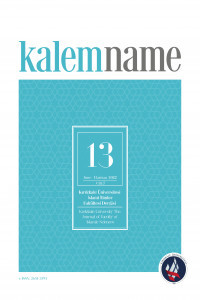Hermeneutik ve Metafor İlişkisi
Hermeneutik, metafor, anlam, metafor ve hermeneutik ilişkisi, yorumlama
HERMENEUTICS AND METAPHOR
Hermeneutics, metaphor, meaning, hermeneutics and metaphor, interpretation,
___
- Aristoteles. Poetika, çev.: İsmail Tunalı, Ankara: Remzi Kitabevi, 1993.
- Aristoteles. Retorik, çev.: Mehmet H. Doğan, İstanbul: YKY, 1995.
- Black, Max. Models and Metaphors, New York: Cornell University Press, 1962.
- Burchert, Donald M. Encyclopedia of Philosophia Encyclopedia of Philosophia, 2nd Edit.
- Cohen, Daniel. Argument and Metaphors in Philosophy, USA: University Press of America, 2004.
- Davidson, Donald. “What Metaphors Mean?”, Critical Inquiry, 5/1, (2001).
- Erhat, Azra. Mitoloji Sözlüğü, İstanbul: Remzi Kitabevi Yayınları, 1996.
- Gadamer, Hans Georg. “Hermeneutik”, Hermeneutik Üzerine Yazılar, çev: Doğan Özlem, İstanbul: İnkılâp Kitabevi, 2003.
- George, Thedore. “Hermeneutics”, Standford Encyclopedia of Philosophy. (https://plato.stanford.edu/entries/hermeneutics/ )
- Göka, Erol. vd. Önce Söz Vardı, Ankara: Vadi Yayınları, 1999.
- Grondin, Jean. Introduction to Philosophical Hermeneutics, USA.: Yale University Press, 1994.
- Johnson, Mark. The Cambridge Handbook of Metaphor and Thought, USA: Cambridge University Press, 2012.
- Lakoff, George-Johnson, Mark Metaforlar: Hayat, Anlam ve Dil, çev. Gökhan Yavuz Demir, İstanbul: Paradigma Yayınları, 2010.
- Mura, Gaspera. “Hermeneutics”, Interdisciplinary Encyclopedia of Religion and Science.(https://inters.org/hermeneutics )
- Porter, S. R. & Robinson, J. C. (2011). Hermeneutics: An Introduction to Interpretive Theory, Wm. B. Eerdmans Publishing Co., Cambridge, UK.
- Richards,Ivor Armstrong. The Philosophy of Rhetoric, Oxford: Oxford University Press, 1993.
- Ricoeur, Paul. “Metaphor And The Main Problem of Hermeneutics”, New Literary History, Baltimore: The Johns Hopkins University Press, 1974.
- Ricoeur, Paul. The Rule of Metafor, çev.: Robert Czerny, Kathleen McLaughlin, John Costello, Toronto: University of Toronto Press, Toronto, 1977.
- Sheehan Richard D. J. “Metaphor as Hermeneutics”, Rhetoric Society Quarterly, 29(2). 1999.
- Simms, Karl. Critical Thinkers-Essential Guides for Literary Studies: Paul Ricoeur, Routledge, 2002.
- Yılmaz, Mehmet. F. “Kutsal Metinleri Anlama ve Hermenötik Metodun Tarihi Birlikteliği”, 11. Uluslararası Türk Dünyası Sosyal Bilimler Kongresi, Kırgızistan, 2013.
- Yayın Aralığı: Yılda 2 Sayı
- Başlangıç: 2016
- Yayıncı: Kırıkkale Üniversitesi
Hermeneutik ve Metafor İlişkisi
İslamcı Dergilerde Hadis Tartışmaları Meseleler, Dönemler ve İsimler
Mapavri (Çayeli) Nahiyesinin Nüfus Yapısı (1835-1846)
Kadın Dindarlığında Coğrafi Bölge Faktörü: Kırıkkale Örneği
Hidayet TUKSAL, Hatice YÖNDEMLİ
Ebû Hayyân el-Endelüsî’nin İrtişâfu’d-Darab Min Lisâni’l-Arab Adlı Eserinde Tevâbi Olgusu
Spinoza’da Tanrı'nın Varlığın ve Tekliğinin Argümanları
Kur'an-ı Kerim ve Kutsal Kitaplarda Hz. Eyyûb
Kuran Eğitiminin Barış İçinde Bir Arada Yaşama Üzerindeki Etkisi
Nābî’nin “Hazret-i Muhyi'd-Dîn'ün” Redifli Kasidesinde İbnü’l-Arabî ve Eserlerine Bakış Açısı
